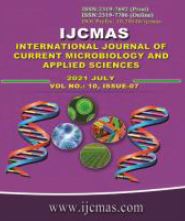


 National Academy of Agricultural Sciences (NAAS)
National Academy of Agricultural Sciences (NAAS)

|
PRINT ISSN : 2319-7692
Online ISSN : 2319-7706 Issues : 12 per year Publisher : Excellent Publishers Email : editorijcmas@gmail.com / submit@ijcmas.com Editor-in-chief: Dr.M.Prakash Index Copernicus ICV 2018: 95.39 NAAS RATING 2020: 5.38 |
Runoff prediction is one of the most important topics in water resources planning, development and management on a sustainable basis. The Generalized Feed Forward (GFF) and Multiple Linear Regression (MLR). This study was undertaken to develop and evaluate the applicability of the GFF and MLR models by way of training and testing of developed models during monsoon period (June to September) for Narmada River Basin in Chota Udaipur district of Gujarat state of India. The daily data of rainfall, runoff, minimum & maximum temperature and wind speed were used in the study for monsoon season. The daily data were split into two sets: a training data set from 2004 to 2008 and a testing data set from 2009 to 2010 for Narmada river basin. The input pairs in the training data set were applied to the network of a selected architecture and training was performed using a back propagation algorithm for GFF models. A number of networks were constructed and each of them was trained separately, and the best network was selected based on the accuracy of the predictions in the testing phase. The following statistical indices such as mean squared error (MSE), coefficient of efficiency (CE), coefficient of determination (R2) and coefficient of correlation (r) were applied to test the performance of the developed GFF and MLR models. The predicted suspended sediment using GFF models were found to be the best performing models for Narmada river basin. It was evident that MLR models fit very poorly for the dataset under study. The current day’s runoff can be simulated using the data of minimum temperature & wind speed (GFF–8).
 |
 |
 |
 |
 |